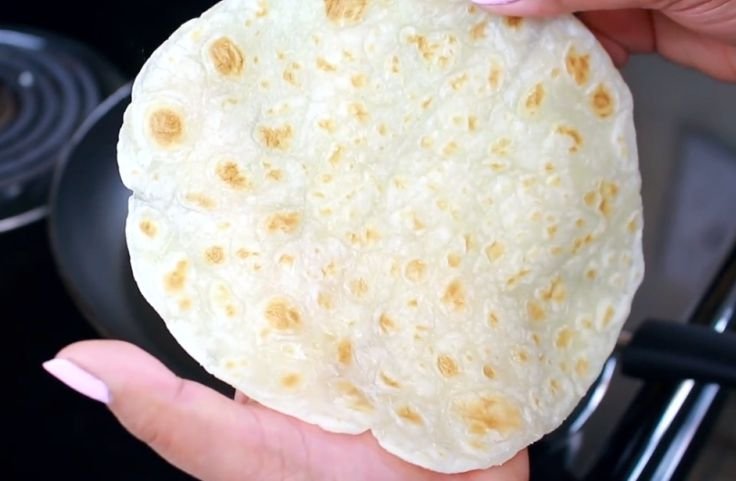Cassava tortillas offer a soft, grain-free wrap made straight from the root of cassava without cassava flour, unlike flour-based versions, bringing a naturally tender texture and authentic taste that’s perfect for tacos, wraps, and wholesome snacking.
When you want a wrap that feels wholesome and satisfying, cassava tortillas give you a simple way to enjoy your meals.
You can use them for tacos, fresh wraps, or even as a quick snack when you need something filling but light.
Their soft bite pairs well with savory or fresh flavors, making them easy to match with whatever you have on hand.
Unlike tortillas made with cassava flour, tortillas from cassava root carry a different experience, one that connects more closely to tradition.
They are naturally gluten-free and grain-free, which makes them appealing to anyone looking for simple swaps in everyday cooking.
As more people choose foods that support their lifestyle, cassava tortillas are becoming a welcome staple in many kitchens worldwide.
Recommended: Cassava Recipes Guide
Table of Contents
- What are Cassava Tortillas without Cassava Flour?
- Homemade Organic Cassava Tortillas vs Cassava Flour Tortillas
- Cassava Tortillas vs Other Gluten-Free Tortillas
- Ingredients and Equipment for Making Homemade Cassava Tortillas without Cassava Flour (Organic)
- How to Make Easy Cassava Tortillas without Cassava Flour from Scratch
- Nutritional Value
- Ways to Use Homemade Cassava Tortillas
- How to Store and Reheat Cassava Tortillas
- Conclusion
- Frequently Asked Questions
What are Cassava Tortillas without Cassava Flour?
Cassava tortillas, different from tapioca tortillas and cassava flour tortillas, are a gluten-free alternative to traditional corn or wheat tortillas, made directly from boiled cassava roots rather than cassava flour.
When used to prepare tortillas, the root creates a wrap that is naturally soft, pliable, and mild in flavor, making it easy to pair with various fillings, such as meats, vegetables, or cheeses.
Their texture feels lighter than wheat tortillas and less earthy than corn tortillas, giving you a more balanced bite.
With the rise of gluten-free eating, cassava tortillas are gaining popularity in both traditional kitchens and modern diets.
It is important to note that they are different from cassava flour tortillas, which are made using ground cassava flour.
Related: Cassava Paleo Recipes
Homemade Organic Cassava Tortillas vs Cassava Flour Tortillas
Cassava tortillas and cassava flour tortillas may share the same root crop, but they differ in how they are prepared and the experience they deliver.
Cassava tortillas are made from boiled cassava roots that are mashed and shaped into soft, chewy wraps.
They give you a closer connection to the original root and carry a naturally tender texture.
Tortillas from cassava flour, on the other hand, are made from dried cassava ground into flour.
This version behaves more like traditional flour-based tortillas, offering a firmer and sometimes drier bite.
While both are naturally gluten-free and grain-free, cassava tortillas lean toward traditional methods, and cassava flour tortillas cater to convenience.
Choosing between them depends on whether you prefer rustic authenticity or ease in everyday cooking.
Related Posts
How to Make the Best Cassava Flour Waffles
How to Make Chips from Cassava Tortillas
Recipe for Vegan Cassava Flour Brownies
Cassava Pancake Recipe With Grated Cassava
Are Cassava Tortillas Healthy? Nutrition and Health Concerns
How to make vegan cassava flour waffles without eggs at home
Cassava Tortillas vs Other Gluten-Free Tortillas
When you look for gluten-free tortillas, cassava tortillas, which are organic give you a balance of texture and flavor that others lack.
Compared with corn, almond flour, and rice tortillas, the difference is clear.
Cassava Tortillas vs Corn Tortillas
Cassava tortillas feel softer in your hands and bend easily without breaking, unlike corn tortillas, which can tear if not handled carefully.
Corn tortillas bring a strong, earthy flavor that might limit your filling choices, while cassava tortillas keep things neutral so your toppings shine.
If you want a wrap that is both pliable and mild in taste, tortillas from cassava root give you more freedom in your cooking.
Cassava Tortillas vs Almond Flour Tortillas
Almond flour tortillas carry a nutty taste that does not suit every dish, and they can crumble when wrapped around heavier fillings.
Cassava tortillas avoid this issue by holding together while remaining soft and chewy.
Their mild flavor works with savory meats, fresh vegetables, or even sweet fillings.
When you want a gluten-free tortilla that supports both flavor and function, cassava tortillas bring a stronger balance than almond flour tortillas.
Cassava Tortillas vs Rice Tortillas
Rice tortillas tend to be sticky and can fall apart with larger portions.
Tortillas from boiled cassava root, however, fold easily and stay intact, making them ideal for tacos, wraps, or quesadillas.
The taste of rice tortillas is plain but lacks the subtle depth you get from cassava.
If you are looking for a tortilla that is reliable, flexible, and works with a wider range of meals, tortillas made from boiled cassava roots stand ahead of rice tortillas.
Related: How to Make Cassava Flour Cookies
Ingredients and Equipment for Making Homemade Cassava Tortillas without Cassava Flour (Organic)
To prepare cassava tortillas at home, you only need cassava root and a few simple tools.
Each item helps you move from root to tortilla with ease and good results.
Cassava Root
Start with fresh cassava root, which is what makes it organic. Peel away the thick skin to reveal the white flesh.
Boil until soft, mashable, and ready to form tortillas. Pick roots that are firm, clean, and free from blemishes.
Knife
Use a sturdy knife to peel and slice cassava into chunks. Its thick, waxy skin needs careful handling.
Cutting evenly sized pieces ensures they boil uniformly, giving you cassava that is easy to mash into dough.
Pot for Boiling
A medium or large pot softens cassava through boiling. Cover the peeled pieces with water and cook until fork-tender.
Proper boiling removes the raw taste and prepares the root for mashing into smooth tortilla dough.
Masher
Once boiled, mash cassava into a smooth dough. Even mashing prevents lumps that make rolling difficult.
A potato masher or sturdy spoon works. The aim is pliable dough that you can knead and shape easily.
I use a spoon or any solid item strong enough to press the soft-boiled cassava into a workable paste.
Slab Top for Kneading
Use a clean slab top to knead cassava dough until smooth. This process balances texture and makes rolling easier.
Lightly oil your hands if sticky. A flat surface ensures tortillas cook evenly in the pan.
Roller
Flatten cassava dough with a rolling pin into thin, even rounds. Roll gently to avoid tearing.
A roller gives better consistency, though hand pressing works in a pinch. Even thickness ensures tortillas cook properly.
Plastic Bag
Place the dough inside a cut-open plastic bag before rolling. This prevents sticking and makes shaping smooth.
It also simplifies transferring tortillas to the pan. A small step that keeps your workspace neat and efficient.
Pan for Cooking
Use a flat pan or skillet to cook cassava tortillas until lightly browned on both sides.
A heavy-bottomed pan distributes heat evenly, preventing burns. Cooking in a pan brings out cassava’s natural flavor.
Related: Cassava Pie Guide: Recipes, Variations, and How to Make It at Home
How to Make Easy Cassava Tortillas without Cassava Flour from Scratch
Making cassava tortillas from scratch is simple and rewarding. With fresh cassava root and a few basic tools, you can prepare gluten-free tortillas that are soft, pliable, and ready for your favorite fillings.
Step 1: Peel and Cut the Cassava
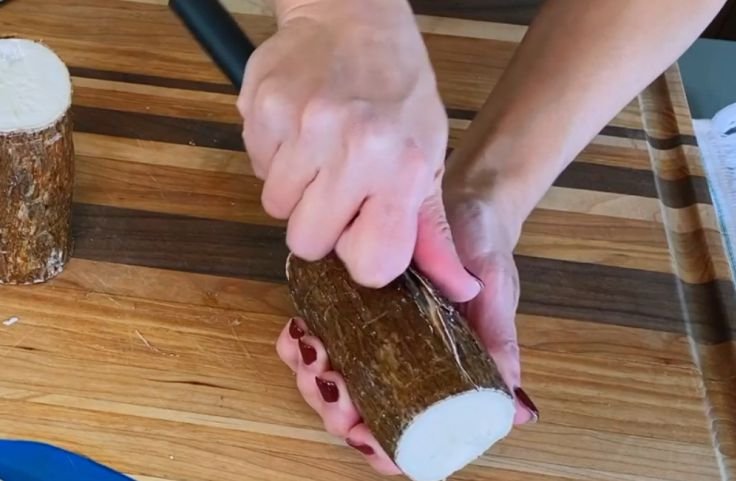
Start with fresh cassava root. Use a sturdy knife to remove the thick outer skin until only the white flesh remains.
Cut the peeled cassava into smaller pieces so they cook evenly. Smaller chunks also make it easier to mash later.
Take your time while peeling to avoid leaving behind tough layers, as these can affect the final texture of your tortillas.
Step 2: Boil the Cassava
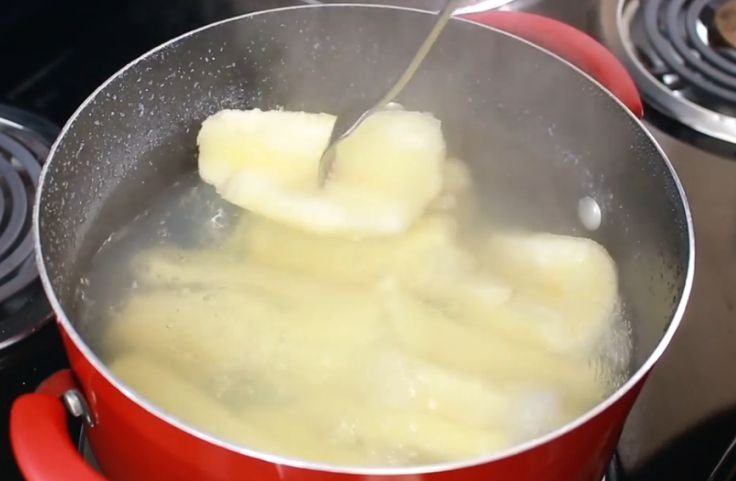
Place the cassava pieces into a medium or large pot and cover them with water as shown in the photo. See how to boil cassava roots.
Bring the pot to a boil and cook the cassava for about 20 to 30 minutes, until fork-tender.
This step softens the root and removes any raw taste. Proper boiling ensures the cassava is ready to mash smoothly, forming a dough that holds its shape when rolled into tortillas.
Step 3: Mash into Dough

Once boiled, drain the cassava and let it cool slightly. Use a masher to crush the cassava into a smooth dough, working out any lumps.
Add a pinch of salt for flavor. If the mixture feels too dry, sprinkle in a little warm water to adjust the consistency.
The goal is soft, pliable dough that kneads easily without sticking too much to your hands.
Step 4: Knead on a Slab Top
Transfer the mashed cassava onto a clean slab top as seen above. Knead it with your hands until smooth and evenly textured.
This step gives structure to the dough and makes rolling easier.
If the dough feels sticky, lightly oil your hands instead of adding too much water.

Kneading on a flat surface ensures the tortillas cook evenly and stay flexible once they leave the pan.
Step 5: Shape and Flatten the Dough
Divide the dough into small balls, each about the size of a golf ball. Place one ball inside a cut-open plastic bag to prevent sticking.


Use a roller to flatten it into a thin, round disc about 1/8 inch thick.
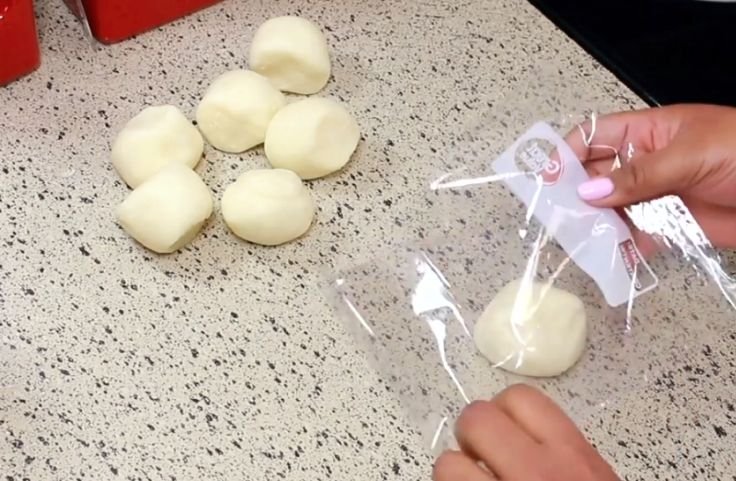
Rolling tortillas inside plastic keeps the surface smooth and makes transferring tortillas to the pan simple without tearing or wasting dough.

Step 6: Cook the Tortillas
Heat a flat pan or skillet over medium heat until hot. Place a flattened tortilla on the surface and cook for two to three minutes on each side.
The tortilla should begin to brown slightly and form small bubbles. Use a spatula to flip carefully.

A heavy-bottomed pan works best to distribute heat evenly and avoid burning while bringing out cassava’s natural flavor.
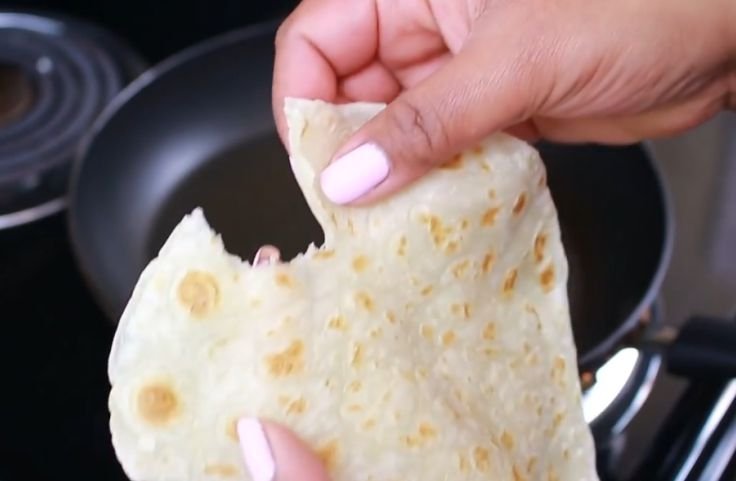
Step 7: Keep Them Warm
As you finish cooking, stack the tortillas on a plate and cover them with a clean cloth to keep them warm.
This prevents them from drying out and keeps them flexible for wrapping.
Warm tortillas are easier to fold around fillings without cracking.
Once ready, serve your cassava tortillas with tacos, wraps, or any dish you enjoy, straight from your kitchen.
Related: How to Make Cassava Flour Bread Rolls
Nutritional Value
Cassava tortillas are a gluten-free and grain-free alternative to wheat tortillas, made from boiled and mashed cassava root.
They are naturally easy to digest, making them suitable for people with celiac disease or gluten sensitivity.
Rich in carbohydrates, about 38 grams per serving, cassava tortillas provide a good energy source but should be balanced with nutrient-dense foods for a well-rounded diet.
Their versatility allows for nutritional enhancement by mixing in beans, lentils, seeds, vegetables, or spices, boosting protein and fiber content while adding flavor.
This adaptability transforms cassava tortillas from a simple carbohydrate base into a more nourishing meal option.
Overall, they are a wholesome choice for those avoiding gluten or grains while seeking energy-rich, customizable food.
See a dedicated article on the full nutritional and caloric value of cassava tortillas.
Related: Guide to Cassava Flour Bread
Ways to Use Homemade Cassava Tortillas
Tortillas from boiled cassava root give you a soft, flexible, and gluten-free option that fits into any meal.
They adapt well to different flavors, making them useful across breakfast, lunch, dinner, or snacks.
Tacos with Cassava Tortillas
You can use cassava tortillas as the base for tacos. Their soft texture holds fillings like grilled chicken, sautéed vegetables, or fish without breaking.
Add avocado, salsa, or fresh herbs, and you get tacos that balance flavor and nutrition while staying gluten-free and grain-free.
Cassava’s mild taste pairs well with bold seasonings, making every bite satisfying.
Breakfast Wraps
For breakfast, tortillas from boiled cassava turn into a quick wrap that fuels your day.
Fill them with scrambled eggs, spinach, cheese, or beans. Add salsa or hot sauce if you like a little heat.
These wraps are easy to carry, perfect for busy mornings, and they keep you satisfied longer thanks to cassava’s steady energy release.
Quesadillas
Cassava root tortillas cook beautifully on a skillet, making them perfect for quesadillas.
You can melt cheese between two tortillas and add beans, roasted vegetables, or shredded beef for extra flavor.
Once toasted to golden brown, the quesadillas stay firm enough to dip into guacamole, sour cream, or salsa. They make a simple but filling lunch.
Sandwich and Wrap Replacements
Instead of bread, use these tortillas for wraps or sandwiches at dinner. They roll easily and hold hearty fillings like turkey, hummus, roasted vegetables, or feta cheese.
Warmed in a pan, they become soft and pliable, turning even simple ingredients into a flavorful meal that works well with gluten-free diets.
Cassava Tortilla Chips
Leftover tortillas from cassava root can be cut into wedges and baked or fried into crispy chips.
These chips work well with dips like salsa, guacamole, or hummus. You can serve them as snacks, appetizers, or party finger food.
Homemade cassava chips are a lighter alternative to store-bought snacks while still delivering crunch and flavor. More on cassava tortilla chips.
Related: Cassava Flour Pancakes Recipe
How to Store and Reheat Cassava Tortillas
Proper storage is essential to keep tortillas soft and flexible. After cooking, let them cool completely, then stack with parchment paper in between each piece.
Place the stack in an airtight container or resealable plastic bag and refrigerate for up to a week.
For longer storage, freezing works best. Use the same stacking method with parchment paper, then seal in a freezer-safe bag while removing excess air.
Stored this way, tortillas can last up to three months without losing quality.
When ready to use, thaw overnight in the fridge or reheat directly from frozen in a skillet.
Reheating restores both flavor and texture. The best method is on a skillet over medium heat for 30 seconds on each side.
Alternatively, cover with a damp paper towel and warm in the microwave in 15-second intervals, being careful not to dry them out.
By storing and reheating cassava tortillas the right way, you maintain their taste and pliability, ensuring they are just as enjoyable when served later.
Conclusion
Homemade cassava tortillas bring wholesome tradition straight to the table. Unlike flour versions, these tortillas use boiled cassava root, giving them a unique texture and subtle, earthy flavor.
Their soft, pliable form makes them perfect for tacos, wraps, or quick everyday meals.
By preparing them directly from the root, you enjoy a naturally gluten-free and grain-free option that supports diverse diets without losing taste or versatility.
Whether you want something new for family dinners or an alternative to corn and wheat, cassava tortillas fit in easily.
With a little preparation, they freeze well, reheat nicely, and offer a reliable base for countless recipes.
Simple, nourishing, and adaptable, tortillas from cassava root keep tradition alive while meeting modern dietary needs.
Frequently Asked Questions
What are cassava tortillas made from?
Cassava tortillas are made by boiling, mashing, and shaping fresh cassava root into soft wraps, offering a grain-free alternative to cassava flour, wheat, or corn tortillas.
Are cassava tortillas healthier than corn tortillas?
Cassava tortillas provide steady energy with fewer allergens, while corn tortillas bring more fiber. The better choice depends on your diet, taste, and meal needs.
How do cassava tortillas taste compared to flour tortillas?
Cassava root tortillas taste mild and slightly earthy, unlike flour tortillas which feel bready. Their soft bite blends easily with savory, fresh, or spicy fillings.
Can tortillas from cassava root be frozen for later use?
Yes. Once cooked, cassava root tortillas can be frozen in layers separated with parchment paper, lasting up to three months while keeping their texture and flavor.
Referencing

Chimeremeze Emeh is a writer and researcher passionate about Africa’s most transformative root crop—cassava. Through his work at cassavavaluechain.com, he explores the entire cassava industry, from cultivation and processing to its diverse applications in food, health, and industrial use.
He also writes for palmoilpalm.com, where he shares his extensive experience and deep-rooted knowledge of palm oil, covering red palm oil, palm kernel oil, and refined products. His work there reflects his lifelong connection to agriculture and his commitment to promoting sustainable value chains in Africa.
Driven by curiosity and purpose, Chimeremeze aims to shed light on how cassava continues to empower communities, strengthen food systems, and link traditional farming wisdom with modern innovation.

